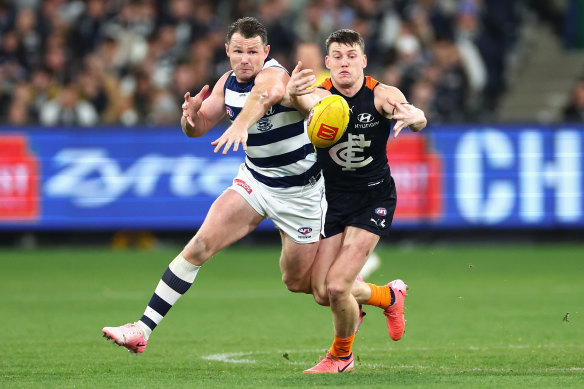“For me, the bigger picture is, what ‘Danger’ did on the field this week could be replicated in junior footy or club footy. They will go, ‘If it’s good enough for him, it’s good enough for me’, and that’s where most of the injuries will occur. My concern is always the bigger picture.”
Gleeson, in his summary, noted that Tuesday’s decision might be considered unusual.
“It will be a rare, even exceptional, case where a player who tackles with significant forward motion, who pins both arms and who could have but does not release one or both arms will not have engaged in rough conduct,” Gleeson said.
“This is such a case.”
The AFL, which continues to work towards reducing head knocks, and is reviewing even tighter measures, such as a limiting contact work at training, was contacted for comment.
The league last year provided players with video footage applauding those who had adjusted their tackling technique, including those who had chosen to pin the arms of an opponent but had themselves slowed their momentum and dropped to their knees when taking an opponent to ground.
Essendon coach Brad Scott, a former AFL operations boss, said on Wednesday that he had expected Dangerfield would be cleared, and that the Cats’ captain explained his position well.
Neurophysiologist Alan Pearce at work.Credit: James Boddington
“I watched it [Dangerfield’s tackle] live and thought he didn’t have a case to answer in the first place,” Scott said.
“The expectation that AFL prosecutors put on [that] you’ve got to release an arm, I think, is realistic.
“When a player who’s got his arm pinned doesn’t get slammed into the ground or, if he does, there’s a suspension that follows, that bit is really clear. There’s a little bit of a challenge for players in between that, but I thought ‘Danger’ exercised the duty of care and tried to hold Walsh up.
“To expect players to pull them back, not let their head hit the ground, but release an arm at the same time and hold with one arm … there’s a lot of expectation on players, and I thought ‘Danger’ explained it pretty well.”
Walsh was not concussed in the tackle and played out the game. He was one of the Blues’ best players.
But Pearce said the bigger picture was the accumulation of minor head knocks, which could lead to chronic traumatic encephalopathy (CTE), a neurodegenerative disease linked with repetitive head trauma.

Patrick Dangerfield closes in on Sam Walsh on Friday.Credit: Getty Images
“How can someone brace their fall when their arms are pinned? And what we do know now about CTE, it’s not about concussion, but the cumulative effects of impacts. That one there, he wasn’t concussed, but it is adding to the accumulation of impacts over many years,” Pearce said.
Loading
Dangerfield’s tackle was assessed by match review officer Michael Christian on Saturday as rough conduct, comprising careless conduct, medium impact and high contact. The AFL’s counsel, Andrew Woods, argued at Tuesday’s hearing that the tackle had potential to cause injury.
“It would have been prudent to let go of one of his [Walsh’s] arms,” Woods said.
“Dangerfield didn’t do enough to discharge the duty that he owed Walsh … and left him in a very vulnerable position.”
Gleeson said Dangerfield had attempted to prevent Walsh from being driven into the ground.
Loading
“The evidence is clear here that Dangerfield immediately swung his legs beside and forward of Walsh [in the tackle], and pulled back with considerable force to attempt to prevent Walsh being driven into the ground,” Gleeson said.
“Given the considerable care Dangerfield went to in a short space of time, in a fast-moving piece of play, to do what he could to avoid or minimise injury to his fellow player, we find that this was not rough conduct.”
Dangerfield said he had no issue confirming he chose to pin both of Walsh’s arms, but insisted that it was the safest option.
“It was the only way for me to have an influence on how hard I laid a tackle. If I was to release one arm in this situation, then I have absolutely no control over the top of his body … to lay an effective tackle without giving away a free kick,” he said.
“I have no doubt at all that it’s my duty of care [which is what I maintained here] to protect the player.”
The tackling player has a duty of care that if the opponent’s arms are pinned, this player’s head is not slammed into the turf.
The AFL – and tribunal – have enforced greater punishment on a range of tackles, including spear and sling tackles.
Keep up to date with the best AFL coverage in the country. Sign up for the Real Footy newsletter.

